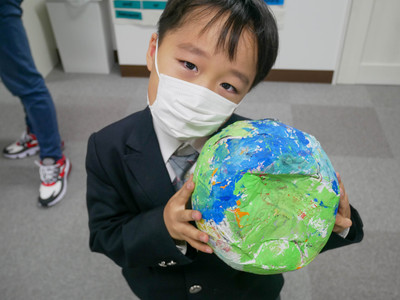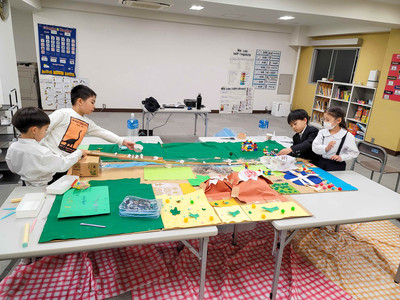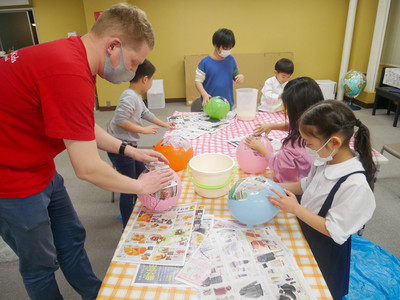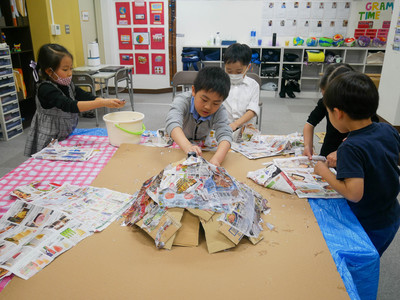Science for Project Work/サイエンスレッスン紹介
Here is an introduction to lessons at CGK Afterschool.
CGKアフタースクールでのレッスンについて紹介いたします。
CGK's eight-week-long project works will be based on the main “Driving Question”.
Here are the Driving Questions for this "Sience" lesson.
CGKの8週間に渡って行うプロジェクト活動では、メインとなる「ドライビングクエスチョン」に基づいて学んでいきます。
今回の「サイエンス」レッスンでのドライビングクエスチョンはこちらです。
How can we keep our communities safe in the face of natural hazards?
「災害が起きたとき、自分たちの住む街でどのように安全を保つのでしょうか?」
The lesson theme was "disaster."
レッスンテーマは「災害」
We followed this theme and question with fun lessons each week that drew the student's interest.
Here are the comments of Mr. Dan, the teacher who was in charge of the lessons.
このテーマと問いに沿って、毎週子供たちの興味を引き出す楽しいレッスンを行いました。
担当していたDan先生のコメントに訳をつけてご紹介します。

Week1
Students brainstormed as many natural hazards as they knew and discussed using a brainstorm. Koushin raised a good question in `what is the difference between a natural hazard and a natural disaster?` which we discussed as a class. We then proceeded to watch a few short video clips and look at a power point presentation focusing on flooding and ways we can keep the community safe and prevent damage. Students were encouraged to give their opinions on various flood defenses from the small and local such as sandbags to very large-scale infrastructure projects such as dams and the large flood defense drainage system under Tokyo that drains potential flood water into the Edo river. Students were then informed that next week we will be conducting an experiment using the environment they made previously where we will simulate a flood. Students used a work sheet to come up with ways to combat the flood ranging from building dams, to clay barriers that simulate flood walls or sandbags. After presenting their ideas students will go away considering what strategy they will use together next week in the limited time they have to prevent the flood. They must work together and find a common path.
生徒たちは知っている限りの自然災害をブレインストームして話し合いました。一人の生徒が「自然ハザードと自然災害の違いは何か」という良い質問をし、クラスで話し合いました。その後、いくつかの短いビデオクリップを見て、パワーポイントを使って、洪水に焦点を当て、地域の安全を守り、被害を防ぐ方法を説明しました。生徒たちは、土嚢のような小さなものから、ダムや東京の地下にある洪水を江戸川に流す大規模な排水システムのような非常に大規模なインフラプロジェクトまで、さまざまな洪水対策について意見を述べるように促されました。そして、来週は以前製作した「街」を使って、洪水をシミュレートする実験を行うことをお話しました。生徒たちはワークシートを使って、ダムを作ったり、洪水の壁を模した粘土の壁や土嚢を作ったりして、洪水に対抗する方法を考えました。自分のアイデアを発表した後、生徒たちは来週の限られた時間の中で、どのような戦略で洪水を防ぐかを一緒に考えます。みんなで協力して、共通の道を見つけなければなりません。
Week 2
This week we talked about the flooding experiment in circle time and brainstormed a little about thoughts they had regarding what they were going to do. For learning centers there were optional centers where students could make lego buildings that they could place on the environment so they could think of ways to protect them during the flood experiment. Another center relating to the experiment was a craft center where students could make flowers, bushes, and trees. The point of this center was to reinforce the idea that vegetation, or the lack of it, has a strong effect of flooding and flood prevention. We had talked about the idea of surface run off the previous week and how concrete, drains, and a lack of vegetation all result in rain water not only not being absorbed and stored in ground water but run off water reaches rivers far quicker than in a natural system resulting in flash flooding. If the students made vegetation and placed it on the environment I would pour less water onto the environment during the experiment as a way to simulate the capture of rain water into the natural system.
今週のサークルタイムでは、洪水の実験について話し、自分たちが何をしようとしているのかについて考えたことについて、少しずつブレーンストーミングを行いました。ラーニングセンターの時間では、オプションのセンターで、生徒がレゴの建物を作り、それを手作りの街の上に置くことで、洪水の実験中にそれらを守る方法を考えることができました。また、実験に関連したセンターとして、花や茂み、木などを作るクラフトセンターがありました。このセンターの目的は、植生の有無が洪水や洪水防止に大きな影響を与えるという考えを強化することでした。前週には、コンクリートや排水溝、植生の不足によって、雨水が地下水に吸収・蓄積されないだけでなく、流出した水が自然のシステムよりもはるかに早く川に到達し、鉄砲水になるという話をしました。生徒が植生を作って環境に置いた場合、雨水が自然のシステムに取り込まれることをシミュレーションする方法として、実験中に環境に注ぐ水の量を少なくします。
Before the experiment we refreshed our minds on various types of flood defenses and then the students were informed that in 25 minutes it would lightly rain, in 35 minutes there would be a rainstorm, and in minutes there would be a heavy rainstorm. This gave the students time to refine their flood defenses each time learning from the previous rainstorm. Students were informed they could use any materials they wanted and had to work together to create flood defenses.
実験の前に、さまざまな種類の洪水防御について再確認し、25分後に小雨、35分後に暴風雨、数分後に大雨が降るという情報を生徒たちに伝えました。これにより、生徒たちは前回の雨を教訓にして、毎回、洪水対策を改善することができました。生徒たちは、好きな材料を使い、協力して洪水対策を作らなければなりませんでした。
Students heavily focused on creating as series of clay dams, and erected barriers of various materials. Students noticeably tried to recreate the Tokyo underground flood defense system that flows storm water into the Edo river by cutting a whole in the cardboard ramp the water would run down, taping a funnel to the underside of the table, and placing a bucket under it. Towards the end students tried to recreate sandbags using bubble wrap. Overall, the students had fun and came up with some interesting ideas. One area that they could have focused more on was the downstream flat portion of the carboard ramp which was the weak point for flooding. Students could have focused their barriers at this area but repeatedly became sidetracked with creating clay dams. However, students worked well as a team and communicated well throughout the experiment and were very helpful towards a student who had joined us for a demo lesson.
学生たちは、一連の粘土のダムを作ることに重点を置き、さまざまな素材のバリアを設置しました。特に注目したのは、雨水を江戸川に流す東京の地下水防システムを再現しようと、水が流れるダンボール製のスロープに穴を開け、テーブルの下に漏斗を貼り付け、その下にバケツを置くというものでした。最後には、プチプチを使って土嚢を再現しました。全体的に、生徒たちは楽しみながら、いくつかの興味深いアイデアを出してくれました。ただ、もっと注目すべきだったのは、浸水の弱点となる板張りのスロープの下流側の平らな部分でした。生徒たちは、この部分にバリアを集中させることができたはずですが、粘土のダムを作るたびに何度も脱線してしまいました。しかし、学生たちはチームワークが良く、実験中のコミュニケーションも良好で、デモレッスンで参加した学生にも親切に対応していました。

Week 3
This week we watched a series of videos, brainstormed, and talked about a power point presentation about the various layers of the Earth. Students were very interested in learning about the Earth`s core, tectonic plates, and continental drift. Learning that the Earth used to have only one big land mass in Pangea and that in the future the world map would look very different seemed to really interest them. We took some extra time to explore the idea of pressure as some boys were convinced that the inner core could not possibly be solid as it is so hot. After we talked about the vast pressure of the inner core they accepted that it is solid. This also lead to an interest in the Earth`s magnetosphere as I mentioned that the liquid outer core moving around the solid inner core is what creates the protective magnetosphere. We will look into this more in depth if time allows. We then made a paper mache model of the Earth by mixing flour and warm water together as a class and using newspaper pasted over a balloon and left to harden. It was messy but a lot of fun.
今週は、一連のビデオを見たり、ブレーンストーミングをしたり、地球の様々な層についてのパワーポイントのプレゼンテーションについて話し合ったりしました。生徒たちは、地球のコア、構造プレート、大陸移動について学ぶことにとても興味を示しました。かつて地球には一つの大きな陸地、パンゲアしかなく、将来は世界地図が大きく変わってしまうことを知って、生徒たちはとても興味を持ったようです。ある男の子たちは、高温の内核が固体であるはずがないと確信していたので、時間を割いて圧力について調べました。内核の膨大な圧力について話した後、彼らはそれが固体であることを認めました。また、液体の外核が固体の内核の周りを動いていることで、保護力のある磁気圏が形成されているという話をしたことで、地球の磁気圏にも興味を持ってくれました。時間が許せば、このことをもっと詳しく調べてみましょう。小麦粉とお湯を混ぜて新聞紙を風船に貼り付けて固め、手作り地球を作りました。汚れてしまいましたが、とても楽しかったです。

Week 4
This week we reviewed what we learned the previous week and moved on to talking about how the layers of the Earth and tectonic plates are responsible for earthquakes. We studied the three main types of tectonic boundaries; convergent, divergent, and transform boundaries. Students were not expected to remember these names but rather the three types of movement and what they are responsible for. We played around with a small game that reinforced what each type does. Once we had studied this we painted our paper mache Earth`s from the previous week. Students were encouraged to be creative with their planets as so long as the core was pained accurately, they could come up with their own planet.
今週は、前週に学んだことを復習し、地球の層や地殻プレートが地震を引き起こす原因となっていることについての話に進みました。地殻変動の境界には、収束境界、発散境界、変形境界の3種類があることを学びました。生徒たちは、これらの名前を覚えるのではなく、3つのタイプの動きと、それらがどのような役割を果たしているかを知ることが求められました。それぞれのタイプが何をするのかをよく理解するために、小さなゲームで遊びました。勉強した後は、前の週に作った手作り「地球」に色を塗りました。芯の部分が正確に塗られていれば、自分の好きな惑星を作ることができるので、生徒たちには創造性を発揮してもらいました。
Week 5-6
During learning centers this week we had a practice emergency evacuation for an earthquake. The students did very well. After the evacuation I talked to them about my old math teacher who told my class to ignore a fire drill as it was only a drill but it turned out to be an actual fire. I was trying to get across to them the importance of always acting like it is not a drill. We then looked through the emergency bag looking at all the items and having the students discuss why they are important and what else we could add to the bag. This week was the start of the third mini project looking at volcanoes this time. We looked at videos, a power point presentation, and brainstormed. This built nicely on from the pervious weeks leaning about the make up of the Earth. Students were very interested in the videos of volcanic eruptions and asked many time if the videos were real. They were also very interested to learn that when larva cools it turns into rock creating new land. We looked at a few videos about new islands created in the sea of Japan recently die to volcanic activity. We then discussed whether volcanoes are good or bad. We then worked as one team to create a coke volcano island using a glue gun to attach cardboard strips to the volcano and the using paper mache to create the cone of the volcano. For presentation students presented the planets they had previous made and talked about things such as how long is one day, how long is one year, what`s the climate like, hat lives there etc. Students then asked question about the planets. Finally, we hung all the planets up in the classroom together to create a mini solar system.
今週のラーニングセンターでは、地震を想定した緊急避難の練習を行いました。生徒たちはとても上手にできました。避難の後、私は昔の数学の先生の話をしました。その先生は私のクラスで消防訓練を無視するように言ったのですが、実際には火事になっていました。私は、常に訓練ではないと思って行動することの大切さを伝えようとしたのです。その後、防災バックに目を通し、すべてのアイテムを見て、なぜそれが重要なのか、他に何を追加すればいいのかを生徒たちに話し合ってもらいました。今週は、火山をテーマにしたミニプロジェクトの3回目が始まりました。ビデオやパワーポイントを見たり、ブレインストーミングをしたりしました。このプロジェクトは、地球の構成について学んだ前週の内容をうまく引き継いでいます。生徒たちは火山噴火のビデオにとても興味を持ち、ビデオは本物かと何度も質問していました。また、幼虫が冷えると岩になり、新しい土地を作るということにも興味を持っていました。私たちは、最近の火山活動によって日本海にできた新しい島についてのビデオをいくつか見ました。そして、火山が良いものか悪いものかを議論しました。グルーガンでコーラのボトルを段ボールに貼り付け、紙粘土で火山の円錐形を作り、チームでコーラの火山島を作りました。その日のプレゼンテーションでは、自分たちが作った惑星を発表し、1日の長さや1年の長さ、気候、そこに住む人などについて話しました。その後、生徒たちは惑星について質問しました。最後に、すべての惑星を教室に吊るして、ミニ太陽系を作りました。
Week 7
During learning centers students started to individually practice for presentation. For project we reviewed what we learned about volcanoes and took a tectonic plate quiz before painting our class volcano.
ラーニングセンターでは、プレゼンテーションのための個人練習を始めました。プロジェクトでは、火山について学んだことを復習し、クラスの火山島を完成させる前にプレートのクイズを行いました。
Week 8
We reviewed what we had learned over the last seven weeks, practiced for presentation, and put the finishing touches to our class volcano. Instead of cola we used a chemical mix we could use red food colouring on instead.
この7週間で学んだことを復習し、プレゼンテーションの練習をして、クラスの火山島の仕上げをしました。コーラの代わりに、赤い食紅を使った化学薬品を使っても良かったかもしれません。

In their presentations, they were able to properly present what they had learned in the lessons about floods, earthquakes, and volcanoes.
It was very cool to see the students presenting what they had created in their own words!
プレゼンテーションでは、洪水、地震、火山とレッスンで学んできたものをきちんと発表することができていました。
自分たちが製作したものを自分たちの言葉でプレゼンしている子供たちはとてもかっこよかったです!
Author Profile
-

-
Saeda Sueki-Au-Yeung - School Director (Japan)

School Director of CGK International School.
Graduated from a 4-year university in America, joined women's soccer team (National Champion).
After working in childcare and management at CGK Preschool and CGK Afterschool, she became the director of the entire CGK International School.





















